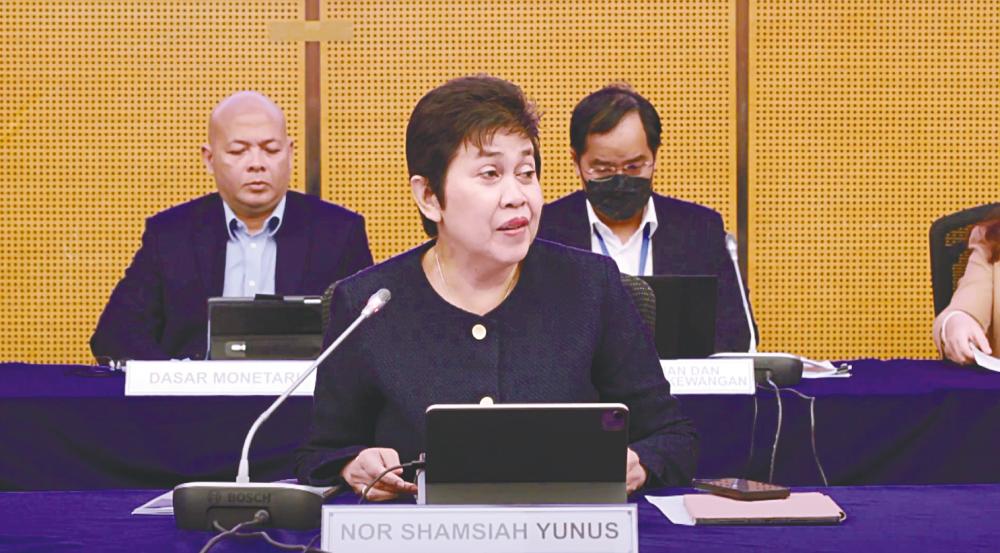KUALA LUMPUR: Malaysia’s banking system remains resilient with ample capacity to absorb losses under severe downside scenarios based on a stress test that ank Negara Malaysia (BNM) conducted.
“The capital and liquidity positions of Malaysian banks remain sound to absorb potential shocks and support intermediation. The banking sector maintains healthy levels of capital and liquidity buffers and is resilient to severely adverse scenarios,” BNM governor Tan Sri Nor Shamsiah Mohd Yunus said during the release of the Bank Negara Malaysia Annual Report 2022 today.
Overall, she said, Malaysian banks are stable and well prepared to face potential shocks and challenges.
The financial institutions’ resilience was assessed against two scenarios spanning over three years that were more severe than the 2008 Global Financial Crisis and the 2020 Covid-10 pandemic, according to BNM’s Financial Stability Review 2022 for the second half of 2022.
Banks in Malaysia continued to maintain healthy liquidity buffers above the regulatory minimum. At the system-wide level, the liquidity coverage and net stable funding ratios remained healthy at 154.0% and 118.2%, respectively.
This has enabled banks to support lending activities, while providing buffers against the impact of rising interest rates on high-quality liquid assets (HQLA) held to meet liquidity needs and other liquidity shocks.
Liquidity and funding risks associated with banks’ exposure to large depositors, who are generally more sensitive to rate movements, remain manageable although some upward pressure on interbank rates has been observed.
The bulk (80%) of banks’ HQLA are in the form of placements with BNM or holdings of government bonds, which can be pledged in the interbank market or with the central bank for additional liquidity under existing standing facilities and the Restricted Committed Liquidity Facility.
Significant deposit concentrations combined with weak capital buffers that could materially increase vulnerabilities to deposit runs are not currently observed among banks in Malaysia.
The central bank said the banking system remains well capitalised. The total capital ratio of the banking system stood at 18.8% at the end of 2022, with capital buffers of RM134.8 billion in excess of the regulatory minimum. Improvements in profitability, along with capital conservation strategies being maintained by most banks, will reinforce the capacity of banks to support intermediation and absorb unexpected losses.
Credit costs have begun to normalise to pre-pandemic levels and are expected to decline further as banks start to write back some of the pandemic-related management overlay provisions. This will provide additional support for banks’ earnings and capital going forward.
Banks, however, remain vigilant over downside risks which could arise from weaker-than-expected economic growth and rising cost pressures affecting loan performance, as well as heightened financial market volatility.
The insurance and takaful sector similarly remained resilient, with an aggregate capital adequacy ratio of 226% and excess capital buffers of RM37.5 billion above the regulatory minimum as at December 2022.
Overall profitability for insurance and takaful funds improved on the back of higher investment returns which helped to offset the higher payouts for medical claims.
The general insurance and takaful sector also performed better, in part due to the absence of large claims recorded in the first half of the year which were caused by severe floods at the end of 2021.
Looking ahead, BNM said insurers and takaful operators (ITO) will remain vulnerable to heightened financial market volatility given their sizeable bond and equity investments.
The continued normalisation of claims in the medical and motor segments, as well as the increasing frequency and severity of physical events such as floods, will have a bearing on the future performance of ITO.
Strong capital and sound reinsurance arrangements remain important to ensure that ITO are adequately resilient against downside risks from such developments.
Based on the latest macro and micro stress tests done, incorporating augmented and additional stress factors, continue to affirm the resilience of financial institutions against unexpected losses from severe macroeconomic and financial shocks.
Post-shock aggregate capital ratios for banks (16.3%), life insurers (164%) and general insurers (211%) remain comfortably above regulatory minima at the end of the stress horizon (2025).
This will continue to firmly underpin the capacity of financial institutions to meet the financing and protection needs of households and businesses.












